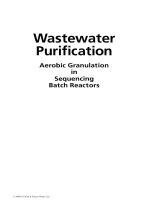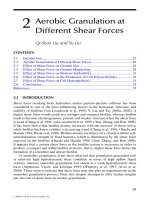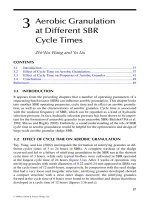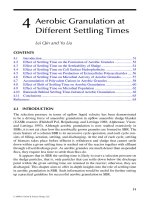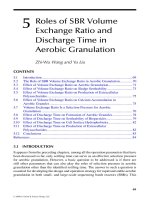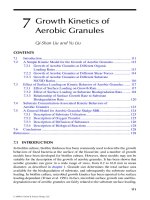Wastewater Purification: Aerobic Granulation in Sequencing Batch Reactors - Chapter 1 pptx
Bạn đang xem bản rút gọn của tài liệu. Xem và tải ngay bản đầy đủ của tài liệu tại đây (716.77 KB, 32 trang )
Aerobic Granulation
in
Sequencing
Batch Reactors
Wastewater
Purification
53671_C000.indd 1 11/6/07 2:01:42 PM
© 2008 by Taylor & Francis Group, LLC
© 2008 by Taylor & Francis Group, LLC
CRC Press is an imprint of the
Taylor & Francis Group, an informa business
Boca Raton London New York
Aerobic Granulation
in
Sequencing
Batch Reactors
Edited by
Yu Liu
Wastewater
Purification
53671_C000.indd 3 11/6/07 2:01:43 PM
© 2008 by Taylor & Francis Group, LLC
© 2008 by Taylor & Francis Group, LLC
CRC Press
Taylor & Francis Group
6000 Broken Sound Parkway NW, Suite 300
Boca Raton, FL 33487-2742
© 2008 by Taylor & Francis Group, LLC
CRC Press is an imprint of Taylor & Francis Group, an Informa business
No claim to original U.S. Government works
Printed in the United States of America on acid-free paper
10 9 8 7 6 5 4 3 2 1
International Standard Book Number-13: 978-1-4200-5367-8 (Hardcover)
This book contains information obtained from authentic and highly regarded sources. Reprinted
material is quoted with permission, and sources are indicated. A wide variety of references are
listed. Reasonable efforts have been made to publish reliable data and information, but the author
and the publisher cannot assume responsibility for the validity of all materials or for the conse-
quences of their use.
Except as permitted under U.S. Copyright Law, no part of this book may be reprinted, reproduced,
transmitted, or utilized in any form by any electronic, mechanical, or other means, now known or
hereafter invented, including photocopying, microfilming, and recording, or in any information
storage or retrieval system, without written permission from the publishers.
For permission to photocopy or use material electronically from this work, please access www.
copyright.com ( or contact the Copyright Clearance Center, Inc. (CCC)
222 Rosewood Drive, Danvers, MA 01923, 978-750-8400. CCC is a not-for-profit organization that
provides licenses and registration for a variety of users. For organizations that have been granted a
photocopy license by the CCC, a separate system of payment has been arranged.
Trademark Notice: Product or corporate names may be trademarks or registered trademarks, and
are used only for identification and explanation without intent to infringe.
Library of Congress Cataloging-in-Publication Data
Wastewater purification : aerobic granulation in sequencing batch reactors /
editor, Yu Liu.
p. cm.
Includes bibliographical references and index.
ISBN 978-1-4200-5367-8 (hardback : alk. paper)
1. Sewage Purification Microbial granulation process. 2.
Sewage Purification Sequencing batch reactor process. I. Liu, Yu.
TD765.65.W37 2006
628.3’2 dc22 2007030300
Visit the Taylor & Francis Web site at
and the CRC Press Web site at
53671_C000.indd 4 11/6/07 2:01:44 PM
© 2008 by Taylor & Francis Group, LLC
© 2008 by Taylor & Francis Group, LLC
v
Contents
Preface vii
Contributors xi
Chapter 1 Aerobic Granulation at Different Carbon Sources and
Concentr ations 1
Qi-Shan Liu and Yu Liu
Chapter 2 Aerobic Granulation at Different Shear Forces 25
Qi-Shan Liu and Yu Liu
Chapter 3 Aerobic Gra nulation at Di fferent SBR Cycle Times 37
Zhi-Wu Wang and Yu Liu
Chapter 4 Aerobic Gra nulat ion at Different Set tl i ng Ti mes 51
Lei Qin and Yu Liu
Chapter 5 RolesofSBRVolumeExchangeRatioandDischargeTimein
Aerobic Granulation 69
Zhi-Wu Wang and Yu Liu
Chapter 6 Selection Pressure Theory for Aerobic Granulation in
Sequencing Batch Reactors 85
Yu Liu and Zhi-Wu Wang
Chapter 7 Growth Kinetics of Aerobic Granules 111
Qi-Shan Liu and Yu Liu
Chapter 8 Diffusion of Substrate and Oxygen in Aerobic Granules 131
Yong Li, Zhi-Wu Wang, and Yu Liu
Chapter 9 The Essential Role of Cell Surface Hydrophobicity in
Aerobic Granulation 149
Yu Liu and Zhi-Wu Wang
53671_C000.indd 5 11/6/07 2:01:44 PM
© 2008 by Taylor & Francis Group, LLC
© 2008 by Taylor & Francis Group, LLC
vi Contents
Chapter 10 Essential Roles of Extracellular Polymeric Substances in
Aerobic Granulation 181
Yu Liu and Zhi-Wu Wang
Chapter 11 Interna l Structure of Aerobic Granules 195
Zhi-Wu Wang and Yu Liu
Chapter 12 Biodegradability of Extracellular Polymeric Substances
Produced by Aerobic Granules 209
Zhi-Wu Wang and Yu Liu
Chapter 13 Calcium Accumulation in Ac etate-Fed Aerobic Granules 223
Zhi-Wu Wang, Yong Li, and Yu Liu
Chapter 14 Inuence of Starvation on Aerobic Granulation 239
Yu Liu, Zhi-Wu Wang, and Qi-Shan Liu
Chapter 15 Filamentous Growth in an Aerobic Granular Sludge SBR 259
Yu Liu and Qi-Shan Liu
Chapter 16 Improved Stability of Aerobic Granules by Selecting
Slow-Growing Bacteria 287
Yu Liu and Zhi-Wu Wang
Chapter 17 Pilot Study of Aerobic Granulation for Wastewater Treatment 301
Qi-Shan Liu and Yu Liu
53671_C000.indd 6 11/6/07 2:01:45 PM
© 2008 by Taylor & Francis Group, LLC
© 2008 by Taylor & Francis Group, LLC
vii
Preface
Biogranulation is a process of microbial self-immobilization, and it can be divided
into two general groups, that is, anaerobic and aerobic granulation. Anaerobic gran
-
ulation has been studied extensively for decades, whereas the interest in aerobic
granulation was started just a few years ago. Aerobic granulation is an environmental
biotechnology developed for the purpose of high-efciency wastewater treatment.
The distinguishing characteristics of aerobic granules attribute superiority to this
technology in comparison with the conventional activated sludge processes. Thus
far, intensive research has been conducted to understand the mechanism of aerobic
granulationinsequencingbatchreactor(SBR)anditsapplicationintreatinga
wide variety of municipal and industrial wastewater. Obviously, the basic research
of aerobic granulation has promoted this technology from laboratory study to the
present pilot- and full-scale applications. This book aims to discuss the up-to-date
research and application of this environmental biotechnology tailored for enhanced
wastewater purication.
-
tioninSBRisindeedinsensitivetothesubstratetypeanditsconcentrationapplied,
although the carbon source seems to inuence the physical properties and micro
-
bialdiversityofmatureaerobicgranules.Itappearsfromthischapterthataerobic
granulationtechnologyisapplicabletothepuricationofawidespectrumofwaste
-
water. Hydrodynamic shear force resulting from intensive aeration in SBR plays an
essential role in aerobic granulation. Chapter 2 elaborates on how hydrodynamic
shear force would inuence aerobic granulation, with special focus on shear force-
associatedchangesinmicrobialactivity,cellsurfaceproperty,andproductionof
extracellular polysaccharides. Hitherto, almost all successful aerobic granulations
areachievedinSBRthatisfeaturedbyitscyclicoperation.Chapter3furtherlooks
intotheroleofSBRcycletimeinaerobicgranulation.
Chapter 4 focuses on understanding the role of settling time in aerobic granula
-
tion,whichisauniqueoperatingparameterofSBRascomparedtoconventional
activated sludge reactors. Settling time is shown as an essential driving force of
aerobic granulation. Aerobic granulation would fail if settling time is not properly
controlled. Aerobic granulation seems to be an effective defensive or protective
strategy of the microbial community against external selection pressure. Chapter 5
identiesthevolumeexchangeratioanddischargetimeofSBRastwootherpos
-
sible driving forces of aerobic granulation in SBR. Further, chapter 6 shows that all
themajorselectionpressuresidentiedsofarcanbeuniedtoaneasyconceptof
the minimal settling velocity that ultimately determines aerobic granulation in SBR.
Thisselectionpressuretheoryoffersusefulguidesforup-scaling,manipulating,and
optimizingaerobicgranularsludgeSBR.
Aerobicgranulationisagradualprocessthatcanbequantitativelydescribedas
change in granule size in the course of SBR operation. In this regard, some kinetic
53671_C000.indd 7 11/6/07 2:01:46 PM
© 2008 by Taylor & Francis Group, LLC
© 2008 by Taylor & Francis Group, LLC
First, chapter 1 presents experimental evidence showing that aerobic granula
viii Preface
models have been developed and presented in chapter 7. Because of the large size
oftheaerobicgranule,massdiffusionlimitationsexistintheaerobicgranule.
Chapter8looksintothediffusionbehaviorsofsubstrateanddissolvedoxygenin
aerobic granules and presents a comprehensive modeling system, which describes
thedynamicdiffusionofsubstrateandoxygeninvarious-sizedaerobicgranules.
Thismodelsystemcanprovideaneffectiveandusefultoolforpredictingandopti
-
mizingtheperformanceofaerobicgranularsludgeSBR.
It is believed that cell-to-cell self-aggregation initiates aerobic granulation. Cell
surfacehydrophobicityservesasanessentialafnityforcethatinitiatestherst
contactofcelltocell.Existingevidenceshowsthatanumberofcultureconditions
can induce cell surface hydrophobicity. Chapter 9 discusses the factors known to
inuence cell surface hydrophobicity. Furthermore, a thermodynamic interpretation
oftheroleofcellsurfacehydrophobicityinaerobicgranulationisalsogiven.The
enrichment culture of highly hydrophobic bacteria thus appears to greatly facilitate
aerobic granulation. Chapter 10 discusses the essential roles of extracellular poly-
saccharides in the formation and maintenance of structural stability of aerobic gran
-
ules. It appears that both the quantity and the quality of extracellular polysaccharides
determinethematrixstructureandintegrityofaerobicgranules.
Chapter 11 reveals that the internal structure of the aerobic granule experiences a
shiftfromhomogenoustoheterogeneousastheaerobicgranulegrowstoabigsizedue
to mass diffusion limitation. Uneven distributions of granule biomass, extracellular
polysaccharides, and cell surface hydrophobicity are also discussed in chapter 11.
Chapter 12 mainly focuses on biodegradability of extracellular polysaccharides pro
-
duced by aerobic granules. Only nonbiodegradable extracellular polysaccharides can
playacrucialprotectiveroleinthegranuleintegritystability,whilebiodegradable
extracellular polysaccharides accumulated at the central part of the aerobic granule
can serve as an additional energy reservoir when an external carbon source is no longer
availableformicrobialgrowth.Chapter13providesaplausibleexplanationforthe
observedhighcalciumaccumulationinacetate-fedaerobicgranulesfrombothexperi
-
mental and theoretical aspects. It is shown that the calcium ion may not be an essential
elementrequiredforsuccessfulaerobicgranulation.
Unlike the continuous activated sludge process, a substrate periodic starvation
exists in aerobic granular sludge SBR due to its cyclic operation. Chapter 14 dis
-
cussesdifferent,evencontroversial,viewswithregardtotheroleofsuchaperiodic
starvation in aerobicgranulation. As lamentous growth has been frequently observed
in aerobic granules, chapter 15 looks into causes and control of lamentous growth
in aerobic granular sludge SBRs. In view of its industrial application, long-term
stabilityofaerobicgranularsludgeSBRremainsamainconcern.Forthispurpose,
chapter 16 sheds light on the possible operation strategy that can help improve the
stability of aerobic granules, including the selection of slow-growing bacteria and
controlofgranuleage.Afternearlytenyearsoflaboratoryresearch,aerobicgranu
-
lation technology has achieved pilot- and full-scale applications. Chapter 17 shows
that successful aerobic granulation can be achieved in pilot-scale SBR using fresh or
stored aerobic granules as seeds.
53671_C000.indd 8 11/6/07 2:01:46 PM
© 2008 by Taylor & Francis Group, LLC
© 2008 by Taylor & Francis Group, LLC
Preface ix
This book presents readers all aspects of aerobic granulation in SBR. The suc-
cessfultestofthistechnologyinpilot-scalestudyforeseesitspromisingapplication
in practical wastewater treatment. I sincerely hope that the publication of this book
willprovideaplatformforthefurtherdevelopmentofthistechnologyandpromote
its quick application in the wastewater treatment industry.
Yu Liu
53671_C000.indd 9 11/6/07 2:01:47 PM
© 2008 by Taylor & Francis Group, LLC
© 2008 by Taylor & Francis Group, LLC
xi
Contributors
Yu Liu, Ph.D.
School of Civil and
Environmental Engineering
Nanyang Technological University
Singapore
Zhi-Wu Wang, Ph.D.
School of Civil and
Environmental Engineering
Nanyang Technological University
Singapore
Qi-Shan Liu, Ph.D.
Singapore Polytechnic
Singapore
Lei Qin, Ph.D.
School of Chemical and
Environmental Engineering
Shanghai University
People’s Republic of China
Yong Li, M.Eng.
School of Civil and
Environmental Engineering
Nanyang Technological University
Singapore
53671_C000.indd 11 11/6/07 2:01:47 PM
© 2008 by Taylor & Francis Group, LLC
© 2008 by Taylor & Francis Group, LLC
1
1
Aerobic Granulation at
Different Carbon Sources
and Concentrations
Qi-Shan Liu and Yu Liu
CONTENTS
1.1 Introduction 1
1.2 Aerobic Granulation with Acetate and Glucose 2
1.2.1 Microscopic Observation of Aerobic Granulation 2
1.2.1.1 Seed Sludge 2
1.2.1.2 Formation of Compact Aggregates after Operation for
One Week 2
1.2.1.3 Formation of Granular Sludge after Operation for
Two Weeks 3
1.2.1.4 Appearance of Mature Granules after Operation for
Three Weeks 4
1.2.2 Characteristics of Glucose- and Acetate-Fed Aerobic Granules 5
1.2.2.1 Morphology 5
1.2.2.2 Sludge Settleability 5
1.2.2.3 Granule Physical Strength and Biomass Density 7
1.2.2.4 Cell Surface Hydrophobicity 7
1.2.2.5 Microbial Activity 7
1.2.2.6 Storage Stability of Aerobic Granules 7
1.3 Aerobic Granulation on Other Carbon Sources 9
1.4 Aerobic Granulation at Different COD Concentrations 9
1.4.1 Effect of COD Concentration on the Properties of
Aerobic Granules 10
1.4.2 Effect of COD Concentration on the Reactor Performance 15
1.5 Aerobic Granulation at Different Substrate N/COD Ratios 15
1.5.1 Effect of N/COD Ratio on the Properties of Aerobic Granules 16
1.5.2 Effect of N/COD Ratio on Population Distribution 18
1.6 Conclusions 20
References 20
1.1 INTRODUCTION
Granulation is a process in which microorganisms aggregate to form a spherical,
densebiomass.Granuleshavebeengrownsuccessfullyineitheranaerobicoraerobic
© 2008 by Taylor & Francis Group, LLC
© 2008 by Taylor & Francis Group, LLC
2 Wastewater Purification
environments(Lettingaetal.1984;Morgenrothetal.1997;Beunetal.1999;J.H.Tay,
Liu, and Liu 2001; Su and Yu 2005). The characteristics of the substrate have been
considered to inuence the formation and structure of anaerobic granules (Wu 1991;
ChenandLun1993).Filamentousanaerobicgranulesdevelopedonvolatilefatty
acids(VFAs)tendtobemechanicallyfragileandlargerinsize,whereasmore
robust, rod-type anaerobic granules were grown on sugar beet or potato processing
wastewater (Adebowale and Kiff 1988). However, the formation of aerobic granules
seems to be independent of the characteristics of the organic substrate (J. H. Tay,
Liu, and Liu 2001).
Another important parameter that affects the anaerobic granulation process and
the characteristics of anaerobic granules is the substrate concentration (Hulshoff
Pol, Heijnekamp, and Lettinga 1988; Campos and Anderson 1992). An appropriate
substrate concentration is critical to the microbial granulation in anaerobic systems.
Morvai et al. (1990) found that anaerobic granulation developed well in upow
anaerobic sludge blanket (UASB) reactors fed with inuent chemical oxygen demand
(COD) concentrations of 1000 to 3000 mg L
–1
,butnotinareactorwithinuentcon-
centration of 500 mg L
–1
. The substrate concentration also has direct impact on the
biolm structure where high surface loading rate leads to the increase of the average
biolmthickness(vanLoosdrechtetal.1995;Tijhuisetal.1996;Kwoketal.1998).
This chapter discusses the effect of substrate carbon source and its concentration on
theformationandcharacteristicsofaerobicgranules.
1.2 AEROBIC GRANULATION WITH ACETATE AND GLUCOSE
1.2.1 M
ICROSCOPIC OBSERVATION OF AEROBIC GRANULATION
J. H. Tay, Liu, and Liu (2001) investigated the evolution process of aerobic granula-
tion in two sequencing batch reactors (SBRs) that were fed with glucose and acetate,
respectively,andmonitoredbymeansofopticalmicroscope,imageanalysis(IA)
technique, and scanning electronic microscope (SEM), and found that aerobic gran
-
ulation is a gradual process from seed sludge to aggregates and nally to compact
mature granules.
1.2.1.1
Seed Sludge
Microscopicexaminationofseedsludgetakenfromasewagetreatmentplant
showed a typical morphology of conventional activated sludge, in which laments
were observed (gure 1.1). A SEM micrograph further revealed that seed sludge had
averylooseandirregularthree-dimensionalstructure(gure1.1C).Theaverageoc
sizeoftheseedsludgewasabout70µm,withasludgevolumeindex(SVI)valueof
280 mL g
–1
, which suggests lamentous bacteria were predominant in the seed sludge
due to its high SVI value (Crites and Tchobanoglous 1998).
1.2.1.2
Formation of Compact Aggregates after Operation for One Week
One week after the reactor startup, lamentous bacteria gradually disappeared in the
acetate-fed SBR, but still prevailed in the glucose-fed SBR. Figure 1.2A shows the
© 2008 by Taylor & Francis Group, LLC
© 2008 by Taylor & Francis Group, LLC
Aerobic Granulation at Different Carbon Sources and Concentrations 3
morphologies of 1-week-old sludge in the glucose-fed SBR observed by imagine analysis.
Thecompactanddensesludgeaggregatescanbeseenandatthisstage,thesludge
aggregates exhibited much more compact and denser structure than the seed sludge.
1.2.1.3
Formation of Granular Sludge after Operation for Two Weeks
Figure1.2Bshowsthesludgemorphologyafteroperationfor2weeks.Itisclearthat
granularsludgewithaclearroundoutershapewasformed.Filamentousbacteria
were still predominant in the reactor fed with glucose, while laments completely dis-
appearedinthereactorfedwithacetateafteroperationfor2weeks.Itisknownthat
a high-carbohydrate substrate composed of glucose or maltose supports the growth
oflamentousbacteria(Chudoba1985).Thismightbethereasonforthelaments-
dominantsituationintheglucose-fedsludge.Ascanbeseeningures1.2Aand
1.2B, the major differences between microbial aggregates and granular sludge can
be attributed to their sizes, compactness, and outer shapes. It should be realized that
the evolution of sludge in both the glucose- and acetate-fed SBRs indeed followed a
similar evolution pattern in the course of operation. These indicate that the carbon
sourcehasaninsignicantinuenceontheformationofaerobicgranulesinSBR.
BA
C
EHT = 15.00 kV WD = 27 mm Mag = 999 X
1 µm
22-Jul-2000 Detector = SE1
FIGURE 1.1 Morphology of seed sludge used for cultivation of aerobic granules. (A) Viewed
by image analysis (scale bar: 2 mm); (B) viewed by optical microscope (scale bar: 5 µm);
(C)viewedbySEM.(FromLiu,Q.S.2003.Ph.D.thesis,NanyangTechnologicalUniversity,
Singapore. With permission.)
© 2008 by Taylor & Francis Group, LLC
© 2008 by Taylor & Francis Group, LLC
4 Wastewater Purification
1.2.1.4 Appearance of Mature Granules after Operation for Three Weeks
Matureaerobicgranuleswereobtainedafter3weeksofoperation(gure1.2C).
Aerobicgranuleshadanaverageroundnessof0.79intermsoftheaspectratio,dened
astheratiobetweentheminoraxisandthemajoraxisoftheellipseequivalenttothe
granule.Maturegranuleshadamuchmoreregular,homogeneousandclearerouter
morphologythanthegranularsludgeobservedafteroperationfor2weeks.Figure1.2
clearlyexhibitsthevisualevolutiontrackoftheaerobicgranulationprocess.TheSEM
micrograph further shows the detailed microstructures of glucose- and acetate-fed
surface, whereas the acetate-fed granules showed a very compact bacterial structure,
in which rod bacteria, tightly linked cell to cell, were found to be predominant. Such
atightcellularstructurewasnotfoundintheseedsludge.
Granular sludge formed
after 2-week operation in
the reactor
Microbial aggregates
formed after 1-week
operation in the reactor
Mature granules appeared
after 3-week operation in
the reactor
A
B
C
FIGURE 1.2 Image analysis of the sludge morphology at different operation times in the
sequencingbatchreactorsfedwithglucoseassubstrate.Scalebar:2mm.(FromTay,J.H.,
Liu, Q. S., and Liu, Y. 2001. J Appl Microbiol 91: 168–175. With permission.)
© 2008 by Taylor & Francis Group, LLC
© 2008 by Taylor & Francis Group, LLC
aerobicgranules(gure1.3).Glucose-fedgranuleshadalaments-dominantouter
Aerobic Granulation at Different Carbon Sources and Concentrations 5
Itcanbeseenfromgures1.1and1.2thattheformationofaerobicgranulesisa
gradual process from seed sludge to dense aggregates, then to granular sludge, and
nally to mature granules. Microscopic observations clearly revealed that micro
-
bial structure could be signicantly strengthened, and further shaped, that is, they
becamemoreandmoreregularanddense,asthegranulationprocessproceeded.In
fact, the sludge-settling property could be improved signicantly after granulation.
SeedsludgeforthereactorstartuphadaSVIvalueof280mLg
–1
with many la-
mentousbacteriapresent(gure1.1).However,anaverageSVIof50to85mLg
–1
was achieved for granules formed from both substrates, which is almost three times
higherthantheoriginalseedsludge.Itisclearthatgranulationleadstoasigni
-
cant improvement in the sludge settleability. The granulation process could take
1to2weeksorevenafewmoreweeksdependingonthesubstrateandthecondi
-
tion of operation. The process will normally take longer for slow-growing bacteria,
for example nitrifying bacteria, and for toxic wastewater (Tsuneda et al. 2003;
S.T.L.Tay,Zhuang,andTay2005;Yietal.2006).Aerobicgranulescanformwith
differentcarbonsources.Itseemsthattheformationofaerobicgranulesisapro
-
cess independent of or insensitive to the characteristics of the substrate (J. H. Tay,
Liu,andLiu2001).However,thesubstratecomponenthasaprofoundimpactonthe
microbialstructureandthediversityofmaturegranules,asdiscussedabove.Infact,
the microstructure of anaerobic granules formed in UASB reactors is also strongly
associated with the substrates (Wu 1991).
1.2.2 CHARACTERISTICS OF GLUCOSE- AND ACETATE-FED AEROBIC GRANULES
The physical characteristics of aerobic granules were more compact compared with
the sludge ocs, while the microbial activity was comparable or somewhat lower
compared with sludge ocs, depending on the size and structure of the granules.
The characteristics of granules cultivated from glucose and acetate substrate are
compared in the following section.
1.2.2.1
Morphology
Thephotographsbyimageanalysisexhibitedthatmaturegranulesformedfromboth
glucoseandacetatesubstrateshadaregularround-shapedstructurewithanaverage
roundnessof0.79intermsofaspectratioforglucose-fedgranules,and0.73foracetate-
whereasthegranulesgrownonacetatehadameandiameterof1.1mm.Theglucose-
fed granules had lamentous bacteria extruding out from the surface (gure 1.3C
andD).However,theacetate-fedgranuleshadasmoothsurfacewithaverycompact
bacterial structure and few laments were observed (gure 1.3A and B).
1.2.2.2
Sludge Settleability
The sludge-settling property is a key operation factor that determines the efciency
of solid–liquid separation, which is essential for the proper functioning of a waste
-
water treatment system. The settleability of aerobic granules was much better than
the sludge ocs of a conventional activated sludge process. The sludge volume
© 2008 by Taylor & Francis Group, LLC
© 2008 by Taylor & Francis Group, LLC
fedgranules(table1.1).Theglucose-fedgranuleshadameandiameterof2.4mm,
6 Wastewater Purification
index (SVI) of the mature granules was 51 to 85 mL g
–1
for glucose-fed granules
and50to80mLg
–1
for acetate-fed granules (table 1.1). The low SVI values indi-
cated the high compactness of the granules. Compared with the seed sludge of SVI
280mLg
–1
,itisobviousthatthesettleabilityofsludgehadimprovedsignicantlyfor
aerobic granules. The average settling velocity of glucose-fed granules was 35 m h
–1
,
and30mh
–1
foracetate-fedgranules.Suchsettlingvelocitiesofaerobicgranulesare
A
B
D
C
# " !!
# " !!
FIGURE 1.3 Scanning electron micrographs of aerobic granule cultivated from acetate
substrate (A) and its surface microstructure (B), and granule cultivated from glucose sub-
strate(C)anditssurfacemicrostructure(D).(FromLiu,Q.S.2003.Ph.D.thesis,Nanyang
Technological University, Singapore. With permission.)
TABLE 1.1
Characteristics of Glucose- and Acetate-Fed Mature Aerobic Granules
Items Glucose-Fed Granules Acetate-Fed Granules
Average diameter (mm) 2.4 (± 0.71) 1.1 (± 0.43)
Aspect ratio 0.79 (± 0.06) 0.73 (± 0.04)
Sludge volume index (mL g
–1
) 51–85 50–80
Settling velocity (m h
–1
) 35 (± 8.5) 30 (± 7.1)
Granule strength (%) 98 (± 0.9) 97 (± 1.2)
Biomass density (g L
–1
) 41.1 (± 6.9) 32.2 (± 9.1)
Hydrophobicity (%) 68 (± 3.9) 73 (± 5.3)
Specic oxygen uptake rate (mg O
2
g
–1
h
–1
) 69.4 (± 8.8) 55.9 (± 7.1)
© 2008 by Taylor & Francis Group, LLC
© 2008 by Taylor & Francis Group, LLC
Aerobic Granulation at Different Carbon Sources and Concentrations 7
comparablewiththatofanaerobicgranulescultivatedinUASB(HulshoffPoletal.
1986;Beeftink1987),andatleastthreetimeshigherthanthoseofactivatedsludge
ocshavingasettlingvelocityoflessthan10mh
–1
.Infact,highsettlingvelocityof
72 m h
–1
wasalsoreportedforaerobicgranules(EttererandWilderer2001).Itcanbe
understoodthatthesettlingvelocitywillbeinuencedbythesizeandcompactness
of the aerobic granules.
1.2.2.3
Granule Physical Strength and Biomass Density
The physical strength of aerobic granules, expressed as the integrity coefcient (%),
whichisdenedastheratioofresidualgranulestothetotalweightofthegranular
sludge after 5 min of shaking at 200 rpm on a platform shaker (Ghangrekar et al.
1996), was 98% for glucose-fed granules and 97% for acetate-fed granules. The higher
the integrity coefcient, the higher is the physical strength of granules. A high integ
-
rity coefcient represents the granule’s ability to withstand high abrasion and shear.
Aerobicgranulescultivatedinbothsubstrateshadahighstrength.Meanwhile,the
maturegranuleshadadrybiomassdensityof41.1gL
–1
for glucose-fed granules, as
determinedbythemethodofBeunetal.(1999),whileitwas32.2gL
–1
for acetate-
fedgranules.Thehigherbiomassdensityofaerobicgranulesreectsadensermicro
-
bial structure. The better settling ability of aerobic granules is consistent with higher
biomass density, which is the result of a denser microbial structure.
1.2.2.4
Cell Surface Hydrophobicity
Theseedsludgeocshadacellsurfacehydrophobicityof39%measuredbythe
hydrocarbonpartitioningmethodofRosenberg,Gutnick,andRosenberg(1980).
Aftertheformationofaerobicgranules,therespectivehydrophobicityofthecell
surface increased to 68% for glucose-fed granules and 73% for acetate-fed granules.
The hydrophobicity of aerobic granules was nearly twice higher than that of the
seed sludge. High cell surface hydrophobicity favors cell attachment and then the
aggregation of the sludge. Cell surface hydrophobicity is considered an important
afnityforceincellattachmentandself-immobilization(DelReetal.2000;Y.Liu
et al. 2003).
1.2.2.5
Microbial Activity
The glucose-fed granules had a microbial activity expressed by specic oxygen
uptake rate (SOUR) at 69.4 mg O
2
g
–1
MLVSS h
–1
, and 55.9 mg O
2
g
–1
MLVSS h
–1
for
acetate-fed granules. The microbial activity of the granules would be strongly asso
-
ciated with the granule size and structure, which inuence the oxygen and substrate
transfer. The most benecial aspect of aerobic granules is their excellent physical
characteristics,whichcouldleadtoahighbiomassconcentrationinthereactor,and
subsequently smaller footprint for the reactor system.
1.2.2.6
Storage Stability of Aerobic Granules
Similar to anaerobic granules, aerobic granules have good storage stability (J. H. Tay,
Liu,andLiu2002;ZhuandWilderer2003).J.H.Tay,Liu,andLiu(2002)foundthat
© 2008 by Taylor & Francis Group, LLC
© 2008 by Taylor & Francis Group, LLC
8 Wastewater Purification
aerobicgranulescultivatedfrombothglucoseandacetatesubstrateshadlittlereduc-
tioninmicrobialactivityafter10daysofstorageat4°Cinarefrigerator(gure1.4).
TheSOURthengraduallydecreasedforbothtypesofgranules,fromtheinitialvalue
of 57 mg O
2
g
–1
biomass h
–1
to6mgO
2
g
–1
biomass h
–1
for acetate-fed granules at
day77,whiletheSOURonlydecreasedto24mgO
2
g
–1
biomass h
–1
for glucose-fed
granulesafter137days,thatis,a60%reductionaftermorethan4monthsofstorage.
Glucose-fedgranulescouldbestoredlongerthanthoseacetate-fedgranuleswith
lessSOURreduction.Thelossinmicrobialactivitywouldbeassociatedwiththe
lengthofstoragetime,thetypeoffeedcarbon,andtheculturehistory.Bothtypes
ofgranuleswerevisuallyingoodgranularshapeafterbeingstoredfor4months,
andnodisintegrationwasobserved.Comparedwiththefreshgranules,thestrength
of the stored granules decreased from 98% to 91% for glucose-fed granules, and
from 97% to 89% for acetate-fed granules. Therefore, aerobic granules could still
maintain good physical strength. Similar to the anaerobic granules, stored aerobic
granules could be used as the seeding material for reactor startup because of its long
storageability.Infact,ZhuandWilderer(2003)foundthatafter7weeksofstorage
SOUR (mg g
–1
VSS h
–1
)
20
30
40
50
60
70
80
Storage Time (days)
0 20 40 60 80 100 120 140
SOUR (mg g
–1
VSS h
–1
)
0
20
40
60
Glucose-fed
Acetate-fed
FIGURE 1.4 Effect of storage time on the microbial activity of aerobic granules cultivated
fromglucoseandacetate,respectively.(DatafromTay,J.H.,Liu,Q.S.,andLiu,Y.2002.
Environ Technol 23: 931–936.)
© 2008 by Taylor & Francis Group, LLC
© 2008 by Taylor & Francis Group, LLC
Aerobic Granulation at Different Carbon Sources and Concentrations 9
of aerobic granules in ambient environment, these aerobic granules could regain
their microbial activity in less than a week.
1.3 AEROBIC GRANULATION ON OTHER CARBON SOURCES
Aerobicgranulescanbeformedwithdifferentorganiccarbonsourcesofacetateand
glucoseasdiscussedabove,whilenitrifyinggranulescanbeformedwithvariousN/COD
ratios,asdiscussedabove.Infact,aerobicgranulationhasbeendemonstratedinavari
-
ety of substrates, including organic/inorganic carbon, toxic wastewater, real municipal
and industrial wastewater, for example, sucrose (Zheng et al. 2006), ethanol (Beun et al.
1999),phenol(Jiang,Tay,andTay2002;J.H.Tay,Jiang,andTay2004;Jiangetal.2006),
pentachlorophenol(Lanetal.2005),and
tert-butylalcohol(S.T.L.Tay,Zhuang,andTay
2005; Zhuang et al. 2005); particulate organic matter-rich wastewater (Schwarzenbeck,
Borges, and Wilderer 2004), domestic sewage (de Kreuk and van Loosdrecht 2006),
andindustrialwastewater(Arrojoetal.2004;Inizanetal.2005;Schwarzenbeck,Erley,
andWilderer2005;SuandYu2005;Wangetal.2007).Phosphorus-accumulating
granuleshavealsobeendevelopedintheSBR(Y.Liu,Lin,andTay2005).
It was reported that nitrifying aerobic granules cultivated possess excellent nitri
-
cation ability (J. H. Tay, Yang, and Liu 2002), while aerobic granules grown on
phenol can enhance the ability of bacteria to tolerate the toxic effect of phenol (Jiang,
Tay, and Tay 2002). It is believed that cell immobilization is a useful strategy for
bacteria to overcome the substrate inhibition associated with high-strength phenolic
wastewater. It was shown that the kinetic behaviors of the phenol-degrading gran
-
ules are subject to the Haldane model, indicating that the phenol-degrading aerobic
granules could counteract the adverse effects of phenol inhibition (Jiang, Tay, and
Tay2002).Theaggregationofmicrobialcellsintocompactgranulesmayserveasan
effective protection against the high phenol concentration. Aerobic granules would
be powerful bioagents for the removal of inhibitory or toxic organic compounds
present in industrial wastewater.
A novel strategy to add the benign co-substrate to toxic substrate to accelerate the
granulationprocessandtheperformanceofthegranularsludgewasproposed(Yietal.
2006).Itwasfoundthatwiththeadditionofglucosetoatoxicsubstrate,
p-nitrophenol
(PNP), the PNP metabolic activity could be enhanced through the formation of
granules. The improvement of metabolic activity is most likely due to the retention
ofspecicPNP-degradingmicroorganismsinthegranules.Thiscouldbetheresult
ofsyntrophicinteractionsbetweenthecommunitymembersinthegranules,while
the metabolic enhancement could result from the increase of specic degradation
activity through the exchange of genetic material among the bacteria in granules. Use
ofaco-substratestrategyinthegranulationprocesscouldimprovethebiodegradation
oftoxicandrecalcitrantorganiccompounds.Thisshowsanotherbenecial aspectof
applying aerobic granulation technology in wastewater treatment.
1.4 AEROBIC GRANULATION AT DIFFERENT
COD CONCENTRATIONS
AerobicgranulescanbeformedinarelativelywiderangeofCODconcentrations
(Q.S.Liu,TayandLiu2003;J.H.Tayetal.2004).Q.S.Liu,TayandLiu(2003)
© 2008 by Taylor & Francis Group, LLC
© 2008 by Taylor & Francis Group, LLC
10 Wastewater Purification
studied the effect of substrate concentration on the formation, structure, and charac-
teristics of aerobic granules and found that granules can be successfully formed with
CODconcentrationsfrom500to3000mgL
–1
, corresponding to an organic loading
rateof1.5to9.0kgCODm
-3
d
–1
.
The formation of aerobic granules at different COD concentrations was a gradual
processfromseedsludgetothematuregranules,withthesameprocessasdiscussed
earlier.Itwasfoundthatafastincreaseinsludgeparticlesizewasobservedinthe
reactorssuppliedwithhighCODconcentrations,forexample,thesizeincreasedto
0.7mmatday10oftheoperationinthereactorfedwithinuentCODof500mgL
–1
,
whileitwas1.0,1.1,and1.4mmforreactorsfedwithinuentCODof1000,2000,
and 3000 mg L
–1
, respectively. It appeared that high substrate concentration favored
a fast increase in granule size. This would be due to the fact that a high substrate
concentrationcansustainfastmicrobialgrowth.
The sludge particle size and SVI variation with the operation time in the reactor
supplied with the highest substrate COD concentration of 3000 mg L
–1
is shown in
gure 1.5. It can be seen that the size of sludge particles gradually increased from
0.09mmtoastablevalueof1.9mmafter20daysofoperation.Withanincrease
insize,thesludgeSVIdecreasedfrom208mLg
–1
to about 35 mL g
–1
accordingly.
These results clearly indicated that the settleability of aerobic granules was much
better than that of seeding sludge bioocs. Figure 1.6 compares the size distribu
-
tionsofseedsludgeandthegranularsludgecultivated,indicatingthatover90%of
the seed sludge particles had a size less than 0.2 mm, while more than 98% of the
granular sludge fell in the size range of 0.4 mm to 3.2 mm. It is clear that the forma
-
tion of aerobic granules seems to be independent of substrate concentration in the
range from 500 to 3000 mg COD L
–1
asdiscussedabove.Infact,otherresearchers
alsosuggestthataerobicgranulescanbeformedinawideCODrange(Moyetal.
2002;J.H.Tayetal.2004).Thisisprobablyduetothenatureofaerobicbacteria.
Comparedtothebiolmprocess,aerobicgranulationisaphenomenonofcell-to-cell
self-immobilizationinsteadofcellattachmenttoasolidsurface.Similartobiolm,
itseemsthatsubstrateconcentrationisnotagoverningfactorfortheformationof
aerobic granules.
1.4.1 EFFECT OF COD CONCENTRATION ON THE PROPERTIES OF
A
EROBIC GRANULES
Acomparisonoftheaveragesizeofaerobicgranulesformedatdifferentsubstrate
concentrationsfoundthatthegranulesizeslightlyincreasedwiththeincrease
ofsubstrateconcentration(gure1.7).Thegranulesizewas1.57mmat500mg
COD L
–1
,whileitincreasedto1.79mmat1000and2000mgCODL
–1
,andfurther
increasedto1.89mmat3000mgCODL
–1
. Moy et al (2002) also found the size
ofaerobicgranulesincreasedwhentheloadingratewasincreased.Asimilar
phenomenon wasobservedinanaerobicgranulation(Grotenhuisetal.1991).This
can be easily understood because high substrate concentration would lead to the
fastbiomassproduction,andnallytoalargesize.Itcanbeexpectedthatthe
granules either of aerobic or anaerobic would have similar growth pattern in rela
-
tion to the substrate concentration.
© 2008 by Taylor & Francis Group, LLC
© 2008 by Taylor & Francis Group, LLC
Aerobic Granulation at Different Carbon Sources and Concentrations 11
The relationship between substrate concentration and granule morphology
expressed by the roundness and aspect ratio found that granules become more irreg
-
ularunderhighsubstrateconcentration,asshowningure1.8.Theaverageround
-
nessofgranuleswas0.69atsubstrateconcentrationof500mgCODL
–1
,whileitwas
0.66, 0.67, and 0.64 at substrate concentrations of 1000, 2000, and 3000 mg COD L
–1
.
The irregularity of the granule surface at high substrate concentration could be due
tothefastgrowthrate.Infact,aheterogeneousandporousbiolmstructurewith
extrusionwasobservedunderhighloadingratecondition(vanLoosdrechtetal.
1995;Kwoketal.1998).
As shown in gure 1.9, the granule strength decreased with the increase of sub
-
strate concentration. The granule strength, expressed as integrity coefcient, was
97%at500and1000mgCODL
–1
,butdroppedto95%at2000mgCODL
–1
,and
0.5
1.0
1.5
2.0
Size (mm)
0
50
100
150
200
250
300
350
SVI (mL g
–1
)
A
3
6
9
12
15
MLSS Concentration (g L
–1
)
B
0
100
200
300
400
500
600
0 1020304050
Operation Time (days)
COD Concentration (mg L
–1
)
C
FIGURE 1.5 Size and SVI variation: (A, $:size;D:SVI),biomass(B)andCODconcentra-
tion (C,
$: inuent (×6); D:efuent)intheoperationtimeinareactorfedwithinuentCOD
of 3000 mg L
–1
.(FromLiu,Q.S.2003.Ph.D.thesis,NanyangTechnologicalUniversity,
Singapore. With permission.)
© 2008 by Taylor & Francis Group, LLC
© 2008 by Taylor & Francis Group, LLC
12 Wastewater Purification
0
0.0 0.1 0.2 0.3 0.4 0.5 0.6 0.7 0.8 0.9 1.0
5
10
15
20
Seed Sludge Size (mm)
% By Volume
A
0
3
6
9
12
15
Granular Sludge Size (mm)
% By Volume
0.4 0.8 1.2 1.6 2.0 2.4 2.8 3.2
B
FIGURE 1.6 Comparison of size distribution by volume between seed sludge (A) and gran-
ularsludge(B)cultivatedinareactorfedwithinuentCODof3000mgL
–1
.(FromLiu,Q.S.,
Tay, J. H., and Liu, Y. 2003. Environ Technol 24:1235–1242.Withpermission.)
1.0
500
1000 2000 3000
1.2
1.4
1.6
1.8
2.0
2.2
Substrate Concentration (mg L
–1
COD)
Size (mm)
FIGURE 1.7 EffectofCODconcentrationonthesizeofmaturegranules.(FromLiu,Q.S.
2003. Ph.D. thesis, Nanyang Technological University, Singapore. With permission.).
© 2008 by Taylor & Francis Group, LLC
© 2008 by Taylor & Francis Group, LLC
Aerobic Granulation at Different Carbon Sources and Concentrations 13
further to 87% at 3000 mg COD L
–1
. The granules formed at the highest substrate
concentrationhaveaveryloosestructure.Thelowerstrengthofaerobicgranulesat
highsubstrateconcentrationscouldalsopossiblybeduetothehighbiomasspro
-
duction rate. This has been reported in anaerobic granules where a high substrate
concentration/loading rate resulted in a reduced strength of anaerobic granules, that
is,thegranuleswouldeasilylosetheirstructuralintegrity,anddisintegrationwould
occur(QuarmbyandForster1995).Morvai,Mihaltz,andCzake(1992)alsofound
that increased loading rate raises the biomass growth rate, and high growth rate of
anaerobic microorganisms would reduce the strength of the three-dimensional struc
-
tureofamicrobialcommunity.
The specic gravity and density of sludge reect the compactness of a microbial
community.ThespecicgravityofgranularsludgeformedinvarioussubstrateCOD
0.60
0.65
0.70
0.75
0.80
0 1000 2000 3000
Substrate Concentration (mg L
–1
COD)
Aspect/Roundness
COD (mg L
–1
)
Roundness
500 0.65 (±0.009) 0.70
0.66
0.66
0.64
1000 0.65 (±0.016)
2000 0.64 (±0.019)
3000 0.66 (±0.018)
Aspect Ratio
FIGURE 1.8 Effect of substrate concentration on granule morphology. &: aspect; F:round-
ness. (From Liu, Q. S. 2003. Ph.D. thesis, Nanyang Technological University, Singapore.
With permission.)
80
85
90
95
100
105
Substrate Concentration (mg L
–1
COD)
Cell Polysaccharides (mg g
–1
VSS)
and Granule Strength
500 1000 2000 3000
FIGURE 1.9 Effect of substrate concentration on the granule polysaccharides contents
(white bar) and granule strength (dark bar) (From Liu, Q. S. 2003. Ph.D. thesis, Nanyang
Technological University, Singapore. With permission.)
© 2008 by Taylor & Francis Group, LLC
© 2008 by Taylor & Francis Group, LLC
14 Wastewater Purification
concentrationsof500to3000mgL
–1
was around 1.010 kg L
–1
,whichisasignicant
increase compared with the seed sludge ocs of 1.001 kg L
–1
(table 1.2). The SVI of
30and40mLg
–1
forgranularsludgealsoimprovedsignicantlyascomparedwith
that of seed sludge of 208 mL g
–1
. The granule density was around 55 g L
–1
at differ-
ent substrate concentrations. However, it seems that substrate concentration has an
insignicant effect on the settleability of the granules.
Theeffectofsubstrateconcentrationoncellpolysaccharidescontentsofaerobic
granules is shown in gure 1.9. The cell polysaccharides content of aerobic gran
-
ulesformedat500mgCODL
–1
was93.6mgg
–1
VSS,whileitwas91.6,84.7,and
85.2 mg g
–1
VSS at 1000, 2000, and 3000 mg COD L
–1
,respectively.Thereisaslight
decrease in polysaccharide content with the increase of substrate concentration. How
-
ever, compared with the cell polysaccharide content of seed sludge of 60.9 mg g
–1
VSS,averysignicantincreasewasobservedbetweentheseedsludgeandgranular
sludge.Itshouldbepointedoutthatthelowerphysicalstrengthofaerobicgran
-
ulesobservedathighCODconcentrationcouldbereasonablyattributedtoitslower
polysaccharides content. It has been generally agreed that cell polysaccharides are
importantinmaintainingthestructuralintegrityofacell-immobilizedcommunity.
It has also been reported that the production of cell polysaccharides was closely
associated with hydrodynamic shear force, as discussed in chapter 2. It is not sur
-
prising that there is no signicant change in cell polysaccharide content with varied
substrate concentration because of its similar shear condition in the reactors.
Cellsurfacehydrophobicityofgranularsludgeseemstohavenorelationshipto
the substrate concentration, as listed in table 1.2. The cell surface hydrophobicity
ofaerobicgranuleswas81%at500mgCODL
–1
, and 84%, 78%, and 79% at 1000,
2000, and 3000 mg COD L
–1
, respectively. However, cell surface hydrophobicity
TABLE 1.2
Characteristics of Aerobic Granules Cultivated at Different
Substrate Concentrations
Parameters
Seed
Sludge
Influent Substrate COD Concentration (mg L
–1
)
500 1000 2000 3000
Size (mm) 0.09 1.57 (± 0.14) 1.79 (± 0.08) 1.79 (± 0.10) 1.89 (± 0.11)
SVI (mL g
–1
) 208 41 (± 4.6) 43 (± 4.3) 36 (± 4.6) 34 (± 3.1)
Biomass density (g L
–1
) ~ 54.3 (± 6.3) 54.7 (± 8.4) 54.6 (± 5.5) 56.1 (± 7.6)
Specic gravity of
sludge (kg L
–1
)
1.001 1.01 (± 0.001) 1.01 (± 0.001) 1.012 (± 0.003) 1.012 (± 0.002)
Biomass concentration
in reactor (g L
–1
)
~ 8.4 (± 1.0) 9.5 (± 1.5) 11.2 (± 1.3) 12.3 (± 1.6)
Cell surface
hydrophobicity (%)
49.4 81.1 (± 4.1) 84.2 (± 5.5) 77.7 (± 3.8) 79.1 (± 4.2)
Efuent COD
concentration (mg L
–1
)
~ 27 (± 9.4) 48 (± 12.3) 68 (± 15.1) 156 (± 35.7)
COD removal
efciency (%)
~ 95 (± 1.7) 95 (± 1.2) 97 (± 1.1) 95 (± 1.2)
© 2008 by Taylor & Francis Group, LLC
© 2008 by Taylor & Francis Group, LLC
Aerobic Granulation at Different Carbon Sources and Concentrations 15
of aerobic granules was much higher than that of seed sludge. Cell surface hydro-
phobicityhasbeengenerallyconsideredtobeanimportantafnityforceintheself-
immobilization and attachment of cells, for example biolm and anaerobic granules
(DelReetal.2000;J.H.Tay,Xu,andTeo2000).Theroleofcellsurfacehydro
-
phobicityinaerobicgranulationwillbediscussedindetailinchapter9.Itcanbe
considered that hydrophobicity might be the force for the initiation of aerobic sludge
granulation.However,thesubstrateconcentrationdidnotseemtoaffectthecell
surface hydrophobicity.
1.4.2 EFFECT OF COD CONCENTRATION ON THE REACTOR PERFORMANCE
The reactor performance, in terms of the efuent COD concentration, exhibited an
increasedtrendwiththesubstrateconcentration.AnaverageefuentCODof27mgL
–1
wasobtainedinthereactorfedwith500mgL
–1
inuentCOD,whileitwas48,68,
and 156 mg L
–1
for reactors fed with 1000, 2000, and 3000 mg L
–1
,respectively.
However, COD removal efciency showed a comparable level in all reactors, which
was above 95%. It should be mentioned that a high biomass concentration of 8.4 to
12.3 g L
–1
was achieved among different reactors at steady state after granulation.
Aerobicgranulationcouldleadtomorebiomassbeingretainedinthereactordue
to good settling property of granular sludge. The high biomass concentration in
reactors favored the performance and stability of biological reactors.
1.5 AEROBIC GRANULATION AT DIFFERENT SUBSTRATE
N/COD RATIOS
Yang, Tay, and Liu (2005) investigated the effect of substrate N/COD ratio on the
formationandphysicalcharacteristicsofaerobicgranules,andfoundthataerobic
granulescanbeformedsuccessfullyinarelativelywiderangeofN/CODratios,from
5/100 to 30/100. Figure 1.10 further illustrates the size change of microbial aggre
-
gatesinthecourseofSBRoperation.Itcanbeseenthatthemeansizeofmicrobial
aggregates cultivated at different substrate N/COD ratios gradually increased and
stabilized over the culture time, while small aerobic granules were obtained at the
high substrate N/COD ratio. Figure 1.10 clearly shows that aerobic granular sludge
reactorscanbestartedupwithinaboutfourweeks.Figure1.11furtherdisplaysa
correlation of SVI of mature aerobic granules with substrate N/COD ratio, indicating
that SVI tended to decrease with the increase of the substrate N/COD ratio and the
lowest SVI of 51 mL g
–1
was found at the highest substrate N/COD ratio of 30/100.
It is reasonable to consider that the substrate N/COD ratio would have a signicant
effect on the structure of microbial granules, that is, a more compact microbial struc
-
turecouldbeexpectedatahighersubstrateN/CODratio.
It seems certain that the use of aerobic granules for upgrading the existing
wastewater treatment plants towards simultaneous organics removal and nitrica
-
tionwouldbefeasibleandbenecial,meanwhilesuchgranulescanalsobeusedto
bioaugment municipal wastewater treatment plant in which washout of nitrifying
biomass is encountered.
© 2008 by Taylor & Francis Group, LLC
© 2008 by Taylor & Francis Group, LLC
16 Wastewater Purification
1.5.1 EFFECT OF N/COD RATIO ON THE PROPERTIES OF AEROBIC GRANULES
ThechangesofSVIwiththetimeofSBRoperationatdifferentN/CODratiosare
ulesonday20onwards,theSVIwasfoundtobeaslowas50mLg
–1
.Moreover,it
appearsfromgures1.10and1.12thatsmalleranddenseraerobicgranuleswould
expect to manipulate the size of aerobic granules by controlling substrate N/COD
positively related to the applied substrate N/COD ratio, that is, aerobic granules
developedathighersubstrateN/CODratioswouldhaveamuchmorecompactand
denser structure. In fact, this observation is consistent with the SVI trend as shown
in gure 1.11.
0.00
0.50
1.00
1.50
2.00
2.50
0 10203040506070
Time (days)
Size (mm)
N/COD: 5/100
N/COD: 10/100
N/COD: 20/100
N/COD: 30/100
FIGURE 1.10 Change in aggregate size versus time in reactors operated at different
substrateN/CODratios.(FromYang,S.F.,Tay,J.H.,andLiu,Y.2005.J Environ Eng
131: 86–92.)
FIGURE 1.11 Sludge volume index of aerobic granules developed at different substrate
N/COD ratios. (From Yang, S. F. 2005. Ph.D. thesis, Nanyang Technological University,
Singapore. With permission.)
© 2008 by Taylor & Francis Group, LLC
© 2008 by Taylor & Francis Group, LLC
50
60
70
80
0.05 0.10 0.20 0.30
N/COD (mg mg
–1
)
SVI (mL g
–1
)
be formed at higher substrate N/COD ratios. This seems to imply that one may
showningure1.12.Itclearlyindicatesthataftertheformationofaerobicgran-
ratio. Figure 1.13 reveals that the specic gravity of aerobic granules seems to be


